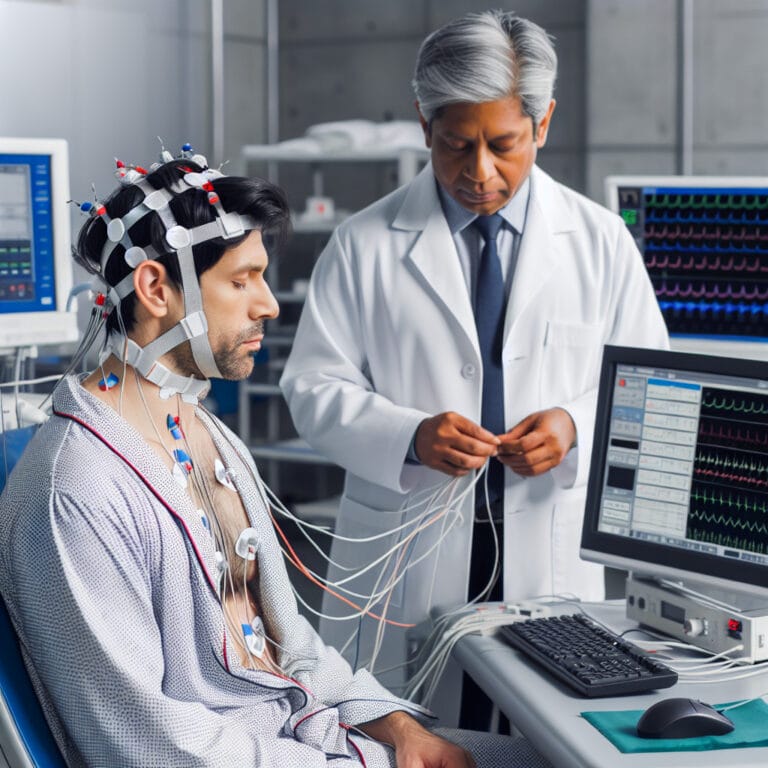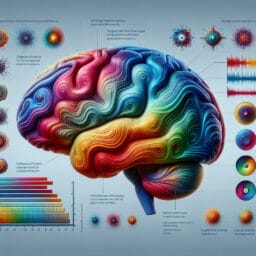
Understanding Polysomnography: Definition, Procedure, and Benefits
Table of Contents
- Introduction: Brief overview of polysomnography
- Definition of Polysomnography
- The Importance of Polysomnography
- The Procedure of Polysomnography: Detailed step-by-step process
- Benefits of Polysomnography
- Risks and Side Effects of Polysomnography
- Conclusion: Recap of the importance and benefits of polysomnography
- Frequently Asked Questions
Introduction: Brief overview of polysomnography
Polysomnography, often referred to as a sleep study, is a cornerstone in the field of sleep medicine. Its pivotal role lies in its ability to provide healthcare providers with a comprehensive understanding of a patient’s sleep patterns. This diagnostic test records several body functions during sleep, such as brain waves, heart rate, muscle movements and oxygen levels. It serves as an invaluable tool in identifying various types of sleep disorders including sleep apnea, thereby aiding your health care provider in prescribing the most efficient therapeutic interventions. Fascinatingly enough, this overnight study not only monitors your physiological parameters while you’re asleep but also measures your sleep latency and different stages of REM (Rapid Eye Movement) and non-REM cycles. Despite appearing like a high-tech endeavor requiring an elaborate setup at a dedicated sleep center or lab staffed by trained technologists; advancements have made it possible for polysomnography to be conducted at home under certain circumstances – ensuring uninterrupted pursuit of normal slumber within one’s comfort zone!
Definition of Polysomnography
Delving deeper into the world of sleep medicine, polysomnography emerges as a quintessential diagnostic tool for healthcare providers. This elaborate sleep study offers an in-depth understanding of one’s physiological activities during sleep, providing essential insights for medical intervention. By monitoring brain waves, heart rate, muscle movements, and oxygen levels while you are asleep, polysomnography paints a comprehensive picture of your sleep patterns. The night-long assessment at a dedicated sleep center or lab captures not just the electrical activity within your brain but also gauges body metrics like heart rhythm and respiratory indicators such as breathing muscles’ performance. Remarkably detailed in its approach, this test records everything from eye movements to leg movements – each data point contributing to an intricate mosaic that reveals the mysteries of your slumber. Sleep latency is another crucial parameter measured during this process – revealing how quickly one transitions from wakefulness to sleep. With these meticulous observations compiled by proficient sleep lab staff members, it becomes feasible to identify various types of sleep disorders including sleep apnea and devise effective treatment strategies accordingly by experts in the field of sleep medicine.
| Term | Description |
|---|---|
| Polysomnography | An elaborate sleep study tool that provides an in-depth understanding of one’s physiological activities during sleep. |
| Monitored Parameters | Brain waves, heart rate, muscle movements, and oxygen levels. |
| Scope | Assessment includes electrical activity within your brain, body metrics like heart rhythm and respiratory indicators such as breathing muscles’ performance. |
| Detail Level | Records everything from eye movements to leg movements, each contributing to a comprehensive picture of your sleep patterns. |
| Sleep Latency | A crucial parameter measured during the process, revealing how quickly one transitions from wakefulness to sleep. |
| Usage | Helps to identify various types of sleep disorders including sleep apnea and devise effective treatment strategies. |
| Performed By | Proficient sleep lab staff members and experts in the field of sleep medicine. |
The Importance of Polysomnography
A pivotal breakthrough in sleep medicine, polysomnography is the unsung hero behind countless successful treatments of sleep disorders. This comprehensive overnight study, often carried out at a dedicated sleep center by experienced staff members, keeps an eye on key physiological parameters while you’re asleep. It’s like having your own personal healthcare provider tracking your heart rate, brain waves, muscle movements and oxygen levels as you drift into the world of dreams. The detailed data captured not only includes REM sleep stages but also chronicles any abnormalities in normal sleep patterns – hand-picking even the slightest signs of potential disorders such as sleep apnea. Furthermore, polysomnography provides an invaluable measurement known as sleep latency – a critical insight into how swiftly one transitions from wakefulness to slumber. This level of granular detail allows for a precise interpretation and analysis that can be vital when formulating effective therapeutic interventions for those wrestling with persistent sleep troubles. Remember, understanding what transpires during our nocturnal journeys through different sleep cycles is crucial in demystifying our unique tempo of rest and rejuvenation; and it’s polysomnography that holds the torchlight leading us through this intricate labyrinth!
The Procedure of Polysomnography: Detailed step-by-step process
A surprising fact for many is that the process of polysomnography, though intricate, is non-invasive and straightforward. Commencing with a comprehensive review of your medical history by a sleep medicine specialist, the procedure requires you to spend a night at an equipped sleep center or lab. The environment here is comfortable and homely, contrary to common assumptions of clinical sterility. As you get ready for sleep, trained staff members attach sensors to your body – these are designed to monitor brain waves, heart rate, respiratory movements and oxygen levels accurately while causing minimal discomfort. They also place electrodes near your eyes and muscles to capture REM sleep stages and any leg movements.
Throughout this overnight study, healthcare providers vigilantly monitor these physiological parameters in real-time via specialized equipment – recording every nuance of your sleep pattern from latency to cycles. This amassed data provides invaluable insights into normal as well as aberrant aspects of your nocturnal physiology; such information can reveal hidden disorders like sleep apnea that may be disrupting your rest unbeknownst to you.
On waking up after this intensive night-long diagnostic test, the sensors are removed painlessly by the proficient staff team who have monitored you throughout the test duration. Post completion of polysomnography, interpretations begin flowing in from skilled professionals; they meticulously analyze each facet before drawing conclusions about any potential underlying conditions.
In essence then; Polysomnography isn’t just an elaborate definition but rather a deep-dive exploration into one’s nocturnal journey through various stages of sleep – providing a revealing mirror image that holds answers for those struggling with elusive daytime fatigue or other puzzling health concerns which may be linked back directly or indirectly to one’s quality (or lack thereof) slumber!
| Step | Description |
|---|---|
| Medical History Review | A sleep medicine specialist conducts a comprehensive review of your medical history. |
| Sleep Center Visit | You are required to spend a night at an equipped sleep center or lab, which is designed to be comfortable and homely. |
| Sensor Attachment | As you get ready for sleep, trained staff members attach sensors to your body to monitor brain waves, heart rate, respiratory movements and oxygen levels. Electrodes are also placed near your eyes and muscles to capture REM sleep stages and any leg movements. |
| Overnight Monitoring | Throughout the night, healthcare providers monitor these physiological parameters in real-time, recording every detail of your sleep pattern from latency to cycles. |
| Data Analysis | The data collected is analyzed to provide insights into normal as well as aberrant aspects of your nocturnal physiology, which can reveal hidden disorders like sleep apnea. |
| Sensor Removal | Upon waking up, the sensors are removed painlessly by the staff team who monitored you throughout the test. |
| Polysomnography Interpretation | After the test, interpretations are made by skilled professionals who analyze each facet before drawing conclusions about any potential underlying conditions. |
Benefits of Polysomnography
Polysomnography – this comprehensive sleep study, plays a pivotal role in not just diagnosing but also managing an array of sleep disorders. By providing a detailed analysis of your brain waves, heart rate, muscle movements and oxygen levels while you’re asleep, the diagnostic test provides healthcare providers with invaluable insights into your unique sleep patterns. Sleep medicine specialists meticulously interpret these findings to guide treatment decisions – ensuring optimal patient outcomes. Moreover, polysomnography’s ability to record REM and non-REM sleep stages offers further understanding into any potential irregularities within your normal sleep cycles. The information unveiled by this overnight study is transformative; from quantifying the severity of apnea through measures like Apnea-Hypopnea Index (AHI) to identifying subtle nuances in daytime sleep study results that may go overlooked otherwise. So whether you’re wrestling with persistent daytime fatigue or suspect an undiagnosed case of Sleep Apnea – remember that help is just a monitored night away at your nearest accredited Sleep Lab!
Risks and Side Effects of Polysomnography
Exploring the landscape of sleep disorders can often be intimidating, particularly when confronted with terms like ‘polysomnography’. However, this intricate diagnostic test, more simply known as a sleep study, can be a game-changer. Conducted typically at an accredited sleep center or lab by proficient staff members, polysomnography monitors various physiological functions while you sleep—capturing brain waves, heart rate, muscle movements and oxygen levels to provide detailed insights into your unique sleep patterns. It’s worth noting that despite its complexity and thoroughness, this non-invasive procedure is devoid of major risks or side effects. Any minor discomfort caused by the application of respiratory sensors and electrodes for monitoring ocular activity and leg movements pales in comparison to the wealth of information it provides about your nighttime rest. This rich tapestry of data helps healthcare providers decode abnormal sleeping patterns like those seen in sleep apnea patients— guiding interventions to enhance your nighttime slumber quality and daytime energy levels. Thus, irrespective of a few manageable challenges such as potential unease during electrode attachment or finding an optimal sleeping position–the benefits offered by this comprehensive home sleep apnea test are truly transformative for those battling persistent tiredness or suspected undiagnosed sleep disorders.
Conclusion: Recap of the importance and benefits of polysomnography
Indispensable in the realm of sleep medicine, polysomnography provides a diagnostic window into our nocturnal physiology that other techniques simply can’t offer. This comprehensive sleep study, performed by skilled staff members at an accredited sleep lab, allows your healthcare provider to monitor key physiological parameters such as brain waves, heart rate, muscle movements and oxygen levels while you’re asleep. The detailed data captured helps identify and manage various sleep disorders including sleep apnea—facilitating optimal patient outcomes through guided therapeutic interventions. From quantifying the severity of apnea through measures like Apnea-Hypopnea Index (AHI) to identifying subtle nuances in daytime sleep study results; polysomnography is truly transformative for those combatting persistent tiredness or suspected undiagnosed disorders. So next time you find yourself counting sheep without avail or feel exhausted despite clocking enough hours on your pillow—it may be worthwhile exploring what goes amiss when the lights go off!



